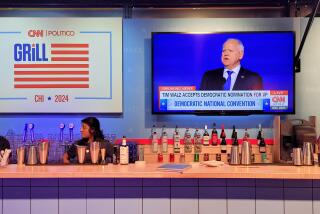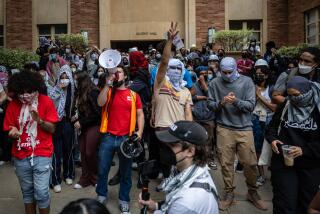Other Media Cover Street Beat
- Share via
PHILADELPHIA — It’s 8 a.m., and the revolution is being shown on public access channels.
Radio host Amy Goodman, seated at a table draped with a blanket, opens her show by reading political headlines on the air, casually dropping the name of the hotel housing the GOP’s largest corporate donors and chatting up a string of protesters, all while a cameraman zaps her image to a rented satellite truck waiting outside.
But unlike the stars of network television, she’s not reading from a script in a sky box above the delegates at First Union Center. She’s in a corner of the Independent Media Center, a shoestring-budget newsroom run out of a downtown apartment building here.
Even as TV news vans raced around the city Monday filming a march against homelessness, local activists contend the major news organizations camped out in Philadelphia are writing them off. So they are trying to shine their own spotlight on the demonstrations with alternative newspaper, television and radio programs. More than 400 people have signed up at the center to write articles, shoot footage or sound off on the airwaves.
“What we’re trying to do is create a platform where other voices can be heard,” said Brian Drolet, an organizer with the Free Speech TV channel, which is carrying the satellite broadcast. If media consolidation results in homogenous news stories, he says, “it doesn’t matter how many channels you have.”
Part of what drives the independent media movement, which also covered demonstrations against the World Trade Organization in Seattle, is the concern that the major print and electronic media’s corporate owners will censor stories that are critical of the companies’ interests. But Philadelphia’s independent media center plays a dual role that would run afoul of ethical boundaries at most professional news organizations: In addition to providing a base for the demonstrators’ documentary crews and radio chats, it houses their public relations arm.
The activists’ “coverage is not influenced by who owns the mechanism for the message,” said Amy Hammersmith, 31, a volunteer writer and editor for the newspaper.
On the other hand, the activists’ work reflects the authors’ approval of the protests they’re covering. Saturday’s edition of the Unconvention newspaper, for example, featured largely positive stories about a tent city activists built for the homeless, past convention protests and a news conference by the so-called R2K protest leaders.
When asked if the newspaper is weighted to promote the demonstrators, Hammersmith said “it’s impossible not to have a lens. I think the word I like to [emphasize] is accuracy, instead of objectivity.”
The Independent Media Center’s drab loft-style space in central Philadelphia is a far cry from the labyrinth of trailers and air-conditioned tents accommodating 15,000 accredited journalists encircling the First Union Center. Writers are typing on computers lugged from home. Organizers are shouting orders on a sound system borrowed from Hammersmith’s boyfriend’s band. And one volunteer slept amid cardboard boxes Monday morning across the room from Goodman’s jury-rigged radio studio as her show went live.
The would-be reporters also face some major hurdles in gathering news. They don’t have credentials to cover the convention itself. And the 7,000-circulation newspaper failed to come out Sunday when they couldn’t find an open printer.
But technology is widening the center’s reach. Goodman’s two-hour program was beamed to the 3.1 million homes subscribing to the Dish Network, 30 public access cable channels around the country, dozens of radio stations in the Pacifica Network and the Internet.
“This is a chance to expose the raw anatomy of power,” Goodman said. “If you think the story is money in politics, [the convention] is where the news is being made. This is what democracy looks like in America today.”
More to Read
Sign up for Essential California
The most important California stories and recommendations in your inbox every morning.
You may occasionally receive promotional content from the Los Angeles Times.













